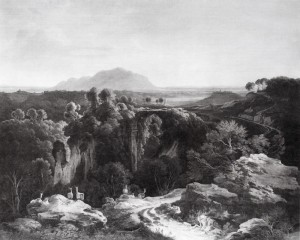August Wilhelm Ferdinand Schirmer (Berlin 1802 - 1866 Nyon, Lake Geneva)
Landscape near Narni, 1829
Oil on paper, laid down on cardboard, 22.3 x 18 cm
Inscribed and dated lower right Narni, 4. May 1829
Provenance:
Private collection, Vienna
Private collection, Italy
August Wilhelm Ferdinand Schirmer[1] was court painter to Crown Prince Friedrich Wilhelm of Prussia, who succeeded Friedrich Wilhelm III as King of Prussia in 1840.[2] Like many of his contemporaries, Schirmer made a number of visits to Italy. His first visit was made possible by a commission from the Crown Prince. He set off in 1827 and spent the years 1828-30 in Rome. His first large-format painting of an Italian landscape and a number of smaller format works were transported to Berlin in 1828 to be exhibited at that year’s ‘Herbst-Ausstellung’.
The scenery of the Campagna Romana and the Colli Albani provided Schirmer with a rich range of motifs. In addition, he was receptive to the influence of the new artistic ideas and practices of his contacts in the international circle of artists working in Rome. He joined the Deutsche Künstlervereinigung and the Ponte Molle Society. He was a founding member of the Rome art association Società di Amatori e Cultori delle Belle Arti. In all probability he met up with Carl Blechen (1797-1840) soon after Blechen’s arrival in Rome in 1829. Blechen was a fellow-student from Berlin and the same age. Records show that the two artists explored the countryside near Rome on study trips.
This oil sketch depicts a landscape showing a section of the Via Flaminia to the north of Rome. The Via Flaminia led directly north from Rome through the mountains of Umbria to Rimini. Schirmer has chosen a viewpoint looking south with the ridge of Monte Soratte in the left distance. The partly overgrown arch of a high bridge carrying the Via Flaminia across one of the ravines between Narni and Otricoli occupies the middle ground. On the bridge, two diminutive figures gaze into the distant plain. The monumentality of the bridge – a fine example of Roman engineering skills – is heightened by its relationship to the surrounding landscape. Despite its relatively small format the visual and perspectival impact of the sketch is striking.

Fig. 1 August Wilhelm Ferdinand Schirmer,
Landscape with Monte Soratte, ‛viewed between Narni and Otricoli’, 1831, oil on canvas, 112 x 141 cm, monogrammed and dated lower left
The sketch was almost certainly executed en plein-air. Schirmer used it – in conjunction with two other oil sketches[3] made on this first visit to Italy – as the basis for one of his major commissions, a large-format landscape executed in 1831 for the Crown Prince. The painting, which has not survived, was titled Landscape with Monte Soratte, ‘viewed between Narni and Otricoli’[4] (Fig. 1).
[1] Not to be confused with the Düsseldorf landscape painter Johann Wilhelm Schirmer (1807-63). [2] See August Wilhelm Ferdinand Schirmer (1802-1866). Ein Berliner Landschaftsmaler aus dem Umkreis Karl Friedrich Schinkels, exhib. cat., Potsdam, Römische Bäder, Berlin 1996. [3] These two oil sketches are:
- Landscape with the Flight into Egypt, 1829, oil on canvas, laid down on board, inscribed, dated and monogrammed lower left Narni 1829 W. S., Hanover, Niedersächsisches Landesmuseum, inv. PNM 523, repr. in Schirmer, op. cit., 1996, no. 2.9, p. 82.
- Landscape, 1829, oil on paper, 26 x 35 cm, formerly in the Fritz von Farenheid collection, Beynuhnen, East Prussia; see Schirmer, op. cit., noted under no. 4.5, p. 128.
The Hanover oil sketch has, until now, been regarded as the only painting known to have been executed by Schirmer on his first visit to Italy.
One of the three sketches was probably exhibited at the Academy exhibition in Berlin in 1830; see Helmut Börsch-Supan, Die Kataloge der Berliner Akademie-Ausstellungen 1786-1850, Berlin 1971, II, 1830, no. 629.
[4] August Wilhelm Ferdinand Schirmer, Landscape with Monte Soratte, ‛viewed between Narni and Otricoli’, 1831, oil on canvas, 112 x 141 cm, monogrammed and dated lower left; see Schirmer, op. cit., 1996, no. 4.5, p. 128 and p. 131, repr.
